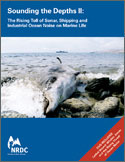Underwater sound pollution threat to marine life says new report
Natural Resources Defense Council release
November 21, 2005
LOS ANGELES (November 21, 2005) — New evidence shows that the rising level of intense underwater sound produced by oil and gas exploration, military sonar and other manmade sources poses a significant long-term threat to whales, dolphins, fish and other marine species, according to a report published today by the Natural Resources Defense Council (NRDC).
The report Sounding the Depths II: The Rising Toll of Sonar, Shipping and Industrial Ocean Noise on Marine Life, is accompanied by a five-minute movie narrated by actor and environmentalist Pierce Brosnan and produced by the firm Imaginary Forces. The film, Lethal Sound, is about harm to marine mammals from high-intensity military sonar and seismic air guns.
“Ocean noise is an insidious form of pollution. The tremendous damage it is doing to life in the sea is becoming more evident with each passing year,” said Michael Jasny, the report’s principal author. “Nations of the world need to work together now to reduce the impacts of ocean noise before the problem becomes unmanageable and the harm to marine life irreversible.”
Intense underwater noise can harm marine life in many ways. Military sonar has been linked to dozens of mass strandings of whales around the world, and oil-and-gas surveys have been shown to damage fish and dramatically reduce catch rates. Despite mounting evidence of harm, there are virtually no safeguards in place to protect marine life. In fact, the U.S. government is blocking international efforts to control the problem.
The NRDC report comes as controversy rages over an Undersea Warfare Training Range that the U.S. Navy hopes to site off Florida, Virginia, or North Carolina, where a mass stranding of whales occurred earlier this year after a U.S. Navy sonar exercise. The training range would see over 160 sonar exercises per year, transforming the acoustic landscape of the region.
In the darkness of the sea, whales, dolphins and other marine animals use sound to navigate while migrating, to locate each other over great distances for mating, to find food, avoid predators, and care for their young. Manmade noise can interfere with all of these activities, testing the ability of marine animals to survive.

|
Sounding the Depths II is the second edition of a widely cited report originally published by NRDC in 1999. The new edition includes:
- The most comprehensive accounting of mass whale strandings related to both military sonar and high energy seismic surveys conducted by the oil and gas industry (pp. 8-9);
- A global map of “hotspots,” showing where industry explores for oil and gas by blasting air guns at the ocean floor (p. 29);
- A roster of active sonar systems used by U.S. and other navies (pp. 22-25);
- The latest scientific findings on noise and whale strandings (p. 6-11);
- A chart of mitigation measures and recommendations for reducing the impacts of ocean noise (p. 19).
There is no longer serious scientific debate about whether marine mammals are dying from intense manmade ocean noise. A range of experts, from the International Whaling Commission’s Scientific Committee to the U.S. Navy’s own commissioned scientists have agreed that the evidence linking mass whale strandings to mid-frequency sonar is convincing and overwhelming.
Mass stranding and mortality events associated with mid-frequency sonar exercises have occurred, among other places, in North Carolina (2005), Alaska (2004), Hawaii (2004), the Canary Islands (2004, 2002, 1991, 1989, 1986, 1985); Madeira (2000), the Bahamas (2000), the U.S. Virgin Islands (1999), and Greece (1997, 1996).
But many scientists believe the greatest threat is the cumulative impact of subtle behavioral change caused by the rising level of ocean noise from a range of sources. In deep water, background noise is growing by three to five decibels per decade in the band occupied by commercial ships. The decibel scale is logarithmic.
Ocean noise is growing from a gamut of military, commercial and industrial sources including dredgers that clear the seabed for ship traffic; high explosives for removing oil platforms and testing naval vessels; construction pile drivers; harassment devices for fisheries; tunnel borers; drilling platforms; oil-and-gas surveys; ships; and commercial and military sonar.
Despite the alarming rise of global ocean noise in recent decades, there is no domestic law or international treaty to deal comprehensively with the problem. To the contrary, the Bush administration is attacking laws such as the Marine Mammal Protection Act and the Endangered Species Act, which have been used to mitigate harm from ocean noise, and has formally opposed “any international regulatory framework addressing military use of active sonar,” no matter what the science may now or in the future suggest.
Sounding the Depths II sets forth a comprehensive strategy for reducing ocean noise pollution. Among other things, it calls for geographic and seasonal restrictions on intense noise from military sonar and seismic air guns; technological improvements to reduce sonic damage; better monitoring and population research; stronger enforcement by the National Marine Fisheries Service, including the management of marine populations for cumulative impacts; and a commitment to international solutions.
The Natural Resources Defense Council
The Natural Resources Defense Council is a national, nonprofit organization of scientists, lawyers and environmental specialists dedicated to protecting public health and the environment. Founded in 1970, NRDC has more than 1 million members and online activists nationwide, served from offices in New York, Washington, Los Angeles and San Francisco.
This is a modified news release from the Natural Resources Defense Council. The original version appears at Sounding the Depths II: The Rising Toll of Sonar, Shipping and Industrial Ocean Noise on Marine Life